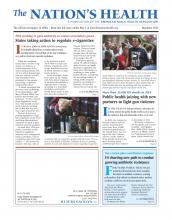Workplace suicides are on the rise and most prevalent among protective service workers, such as police officers, according to a recent study.
The findings come from research published online March 16 in the American Journal of Preventive Medicine.
“The lines between personal and work life are shrinking,” said Hope Tiesman, PhD, a study author and epidemiologist with the National Institute for Occupational Safety and Health’s Division of Safety Research. “We know that suicide is multi-factorial in nature; therefore, we need to take advantage of multiple opportunities to intervene in an individual’s life — including the workplace.”
Researchers analyzed data from 2003 to 2010 on workplace suicides from the Bureau of Labor Statistics’ Census of Fatal Occupational Injury database. They used the Web-Based Injury Statistics Query and Reporting Systems database from the Centers for Disease Control and Prevention to analyze non-workplace suicides for a comparison.
More than 1,700 Americans died by suicide at their jobs between those years and workplace suicides climbed after 2007, despite a decrease between 2003 and 2007, the study found.
Protective service workers, such as people in law enforcement and firefighting, had the highest suicide rate — 3.5 times greater than the overall U.S. workplace suicide rate of 1.5 people per 1 million people, the study said. Eighty-four percent of those suicides involved the use of a firearm.
In addition, men and people ages 65 to 74 had the highest workplace suicide rates. An average of 2.7 men per 1 million people died by suicide at work compared to 0.2 women per 1 million people.
When compared with non-work suicides, more than 270,000 people died by suicide outside of their jobs between 2003 and 2010, with a gradual increase in suicides during that time period, the study said. People ages 45 to 54 were among the highest non-work suicide rates, the study said.
Tiesman said mental health providers should be mindful of how jobs may influence workers’ risk for suicide, especially for people who work in protective service occupations and also jobs in the farming, fishing and forestry industries. She added that jobs linked to high suicide risks could also be potential targets for mental health interventions.
“Occupational safety and health professionals should recognize that non-work factors can and do contribute to safety and health issues on the job,” Tiesman told The Nation’s Health.
For more information, visit http://www.ajpmonline.org/article/S0749-3797%2814%2900722-3/abstract.
- Copyright The Nation’s Health, American Public Health Association









